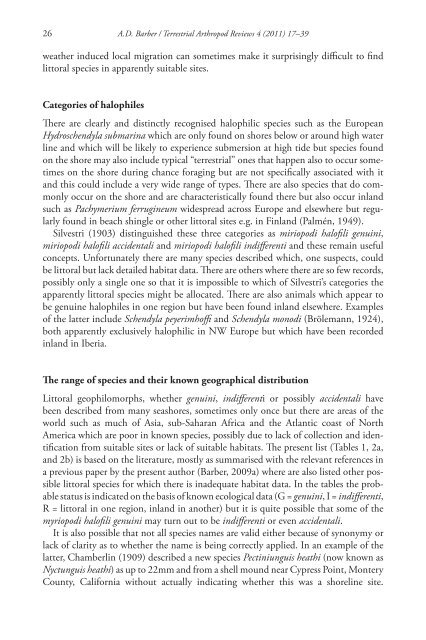Geophilomorph centipedes and the littoral habitat - Books and ...
Geophilomorph centipedes and the littoral habitat - Books and ...
Geophilomorph centipedes and the littoral habitat - Books and ...
Create successful ePaper yourself
Turn your PDF publications into a flip-book with our unique Google optimized e-Paper software.
26 A.D. Barber / Terrestrial Arthropod Reviews 4 (2011) 17–39<br />
wea<strong>the</strong>r induced local migration can sometimes make it surprisingly diffi cult to fi nd<br />
<strong>littoral</strong> species in apparently suitable sites.<br />
Categories of halophiles<br />
Th ere are clearly <strong>and</strong> distinctly recognised halophilic species such as <strong>the</strong> European<br />
Hydroschendyla submarina which are only found on shores below or around high water<br />
line <strong>and</strong> which will be likely to experience submersion at high tide but species found<br />
on <strong>the</strong> shore may also include typical “terrestrial” ones that happen also to occur sometimes<br />
on <strong>the</strong> shore during chance foraging but are not specifi cally associated with it<br />
<strong>and</strong> this could include a very wide range of types. Th ere are also species that do commonly<br />
occur on <strong>the</strong> shore <strong>and</strong> are characteristically found <strong>the</strong>re but also occur inl<strong>and</strong><br />
such as Pachymerium ferrugineum widespread across Europe <strong>and</strong> elsewhere but regularly<br />
found in beach shingle or o<strong>the</strong>r <strong>littoral</strong> sites e.g. in Finl<strong>and</strong> (Palmén, 1949 ).<br />
Silvestri ( 1903 ) distinguished <strong>the</strong>se three categories as miriopodi halofi li genuini ,<br />
miriopodi halofi li accidentali <strong>and</strong> miriopodi halofi li indiff erenti <strong>and</strong> <strong>the</strong>se remain useful<br />
concepts. Unfortunately <strong>the</strong>re are many species described which, one suspects, could<br />
be <strong>littoral</strong> but lack detailed <strong>habitat</strong> data. Th ere are o<strong>the</strong>rs where <strong>the</strong>re are so few records,<br />
possibly only a single one so that it is impossible to which of Silvestri’s categories <strong>the</strong><br />
apparently <strong>littoral</strong> species might be allocated. Th ere are also animals which appear to<br />
be genuine halophiles in one region but have been found inl<strong>and</strong> elsewhere. Examples<br />
of <strong>the</strong> latter include Schendyla peyerimhoffi <strong>and</strong> Schendyla monodi (Brölemann, 1924),<br />
both apparently exclusively halophilic in NW Europe but which have been recorded<br />
inl<strong>and</strong> in Iberia.<br />
Th e range of species <strong>and</strong> <strong>the</strong>ir known geographical distribution<br />
Littoral geophilomorphs, whe<strong>the</strong>r genuini , indiff erent i or possibly accidentali have<br />
been described from many seashores, sometimes only once but <strong>the</strong>re are areas of <strong>the</strong><br />
world such as much of Asia, sub-Saharan Africa <strong>and</strong> <strong>the</strong> Atlantic coast of North<br />
America which are poor in known species, possibly due to lack of collection <strong>and</strong> identifi<br />
cation from suitable sites or lack of suitable <strong>habitat</strong>s. Th e present list ( Tables 1, 2a,<br />
<strong>and</strong> 2b ) is based on <strong>the</strong> literature, mostly as summarised with <strong>the</strong> relevant references in<br />
a previous paper by <strong>the</strong> present author (Barber, 2009a ) where are also listed o<strong>the</strong>r possible<br />
<strong>littoral</strong> species for which <strong>the</strong>re is inadequate <strong>habitat</strong> data. In <strong>the</strong> tables <strong>the</strong> probable<br />
status is indicated on <strong>the</strong> basis of known ecological data (G = genuini , I = indiff erenti ,<br />
R = <strong>littoral</strong> in one region, inl<strong>and</strong> in ano<strong>the</strong>r) but it is quite possible that some of <strong>the</strong><br />
myriopodi halofi li genuini may turn out to be indiff erenti or even accidentali .<br />
It is also possible that not all species names are valid ei<strong>the</strong>r because of synonymy or<br />
lack of clarity as to whe<strong>the</strong>r <strong>the</strong> name is being correctly applied. In an example of <strong>the</strong><br />
latter, Chamberlin ( 1909 ) described a new species Pectiniunguis heathi (now known as<br />
Nyctunguis heathi ) as up to 22mm <strong>and</strong> from a shell mound near Cypress Point, Montery<br />
County, California without actually indicating whe<strong>the</strong>r this was a shoreline site.









![Am HaSefer [Volk des Buches] - Books and Journals](https://img.yumpu.com/20648352/1/174x260/am-hasefer-volk-des-buches-books-and-journals.jpg?quality=85)







